Coralline algae
Coralline algae are red algae in the order Corallinales. They are characterized by a thallus that is hard because of calcareous deposits contained within the cell walls. The colors of these algae are most typically pink, or some other shade of red, but some species can be purple, yellow, blue, white, or gray-green. Coralline algae play an important role in the ecology of coral reefs. Sea urchins, parrot fish, and limpets and chitons (both mollusks) feed on coralline algae. In the temperate Mediterranean Sea, coralline algae are the main builders of a typical algal reef, the Coralligène ("coralligenous").[5] Many are typically encrusting and rock-like, found in marine waters all over the world. Only one species lives in freshwater.[6] Unattached specimens (maerl, rhodoliths) may form relatively smooth compact balls to warty or fruticose thalli.
| Coralline algae Temporal range: | |
|---|---|
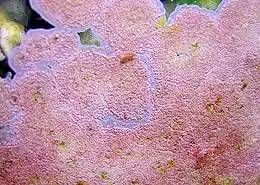 | |
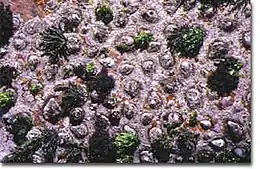 | |
| Spongites yendoi together with the gardening limpet Scutellastra cochlear | |
| Scientific classification | |
| (unranked): | Archaeplastida |
| Division: | Rhodophyta |
| Class: | Florideophyceae |
| Subclass: | Corallinophycidae |
| Order: | Corallinales Silva & Johansen, 1986[4] |
| Families and subfamilies | |
| |
A close look at almost any intertidal rocky shore or coral reef will reveal an abundance of pink to pinkish-grey patches, distributed throughout the rock surfaces. These patches of pink "paint" are actually living crustose coralline red algae. The red algae belong to the division Rhodophyta, within which the coralline algae form the order Corallinales. There are over 1600 described species of nongeniculate coralline algae.[7]
The corallines are presently grouped into two families on the basis of their reproductive structures.[8]
Distribution
Coralline algae are widespread in all of the world's oceans, where they often cover close to 100% of rocky substrata. Only one species, Pneophyllum cetinaensis, is found in freshwater. Its ancestor lived in brackish water, and was already adapted to osmotic stress and rapid changes in water salinity and temperature.[6][9] Many are epiphytic (grow on other algae or marine angiosperms), or epizoic (grow on animals), and some are even parasitic on other corallines. Despite their ubiquity, the coralline algae are poorly known by ecologists, and even by specialist phycologists (people who study algae). For example, a recent book on the seaweeds of Hawaii does not include any crustose coralline algae, even though corallines are quite well studied there and dominate many marine areas.
Forms
Corallines have been divided into two groups, although this division does not constitute a taxonomic grouping:
- the geniculate (articulated) corallines;
- the nongeniculate (nonarticulated) corallines.
Geniculate corallines are branching, tree-like organisms which are attached to the substratum by crustose or calcified, root-like holdfasts. The organisms are made flexible by having noncalcified sections (genicula) separating longer calcified sections (intergenicula). Nongeniculate corallines range from a few micrometres to several centimetres thick crusts. They are often very slow growing, and may occur on rock, coral skeletons, shells, other algae or seagrasses. Crusts may be thin and leafy to thick and strongly adherent. Some are parasitic or partly endophytic on other corallines. Many coralline crusts produce knobby protuberances ranging from a millimetre to several centimetres high. Some are free-living as rhodoliths (rounded, free-living specimens). The morphological complexity of rhodoliths enhances species diversity, and can be used as a non-taxonomic descriptor for monitoring.[10]
Thalli can be divided into three layers: the hypothallus, perithallus and epithallus.[11] The epithallus is periodically shed, either in sheets or piecemeal.[12]
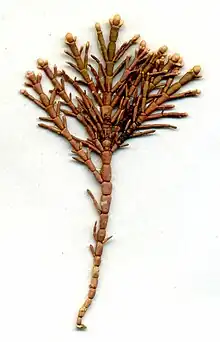
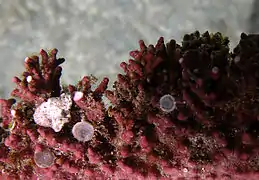 Lithothamnion sp.
Lithothamnion sp.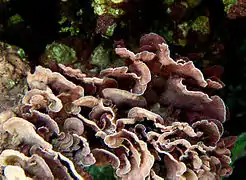 Mesophyllum sp.
Mesophyllum sp.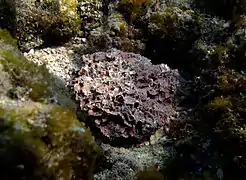 Unidentified encrusting species
Unidentified encrusting species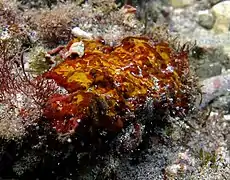 idem
idem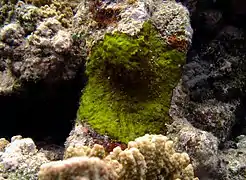 idem
idem
Habitat
Corallines live in varying depths of water, ranging from periodically exposed intertidal settings to 270 m water depth (around the maximum penetration of light).[13] Some species can tolerate brackish[13] or hypersaline[14] waters, and only one strictly freshwater coralline species exists.[6] (Some species of the morphologically similar, but non-calcifying, Hildenbrandia, however, can survive in freshwater.) A wide range of turbidities and nutrient concentrations can be tolerated.[13]
Growth
Corallines, especially encrusting forms, are slow growers, and expand by 0.1–80 mm annually.[13] All corallines begin with a crustose stage; some later become frondose.[15]
Avoidance of fouling
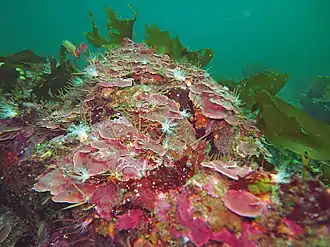
As sessile encrusting organisms, the corallines are prone to overgrowth by other "fouling" algae. The group have many defences to such immuration, most of which depend on waves disturbing their thalli. However, the most relied-upon method involves waiting for herbivores to devour the potential encrusters.[17] This places them in the unusual position of requiring herbivory, rather than benefiting from its avoidance.[18] Many species periodically slough their surface epithallus – and anything attached to it.[17]
Some corallines slough off a surface layer of epithallial cells, which in a few cases may be an antifouling mechanism which serves the same function as enhancing herbivore recruitment. This also affects the community, as many algae recruit on the surface of a sloughing coralline, and are then lost with the surface layer of cells. This can also generate patchiness within the community. The common Indo-Pacific corallines, Neogoniolithon fosliei and Sporolithon ptychoides, slough epithallial cells in continuous sheets which often lie on the surface of the plants.
Not all sloughing serves an antifouling function. Epithallial shedding in most corallines is probably simply a means of getting rid of damaged cells whose metabolic function has become impaired. Morton and his students studied sloughing in the South African intertidal coralline alga, Spongites yendoi, a species which sloughs up to 50% of its thickness twice a year. This deep-layer sloughing, which is energetically costly, does not affect seaweed recruitment when herbivores are removed. The surface of these plants is usually kept clean by herbivores, particularly the pear limpet, Patella cochlear. Sloughing in this case is probably a means of eliminating old reproductive structures and grazer-damaged surface cells, and reducing the likelihood of surface penetration by burrowing organisms.
Evolutionary history
The corallines have an excellent fossil record from the Early Cretaceous onwards, consistent with molecular clocks that show the divergence of the modern taxa beginning in this period.[1] The fossil record of nonarticulated forms is better: the unmineralized genuiculae of articulated forms break down quickly, scattering the mineralized portions, which then decay more quickly.[1] This said, non-mineralizing coralline algae are known from the Silurian of Gotland[19] showing that the lineage has a much longer history than molecular clocks would indicate.
The earliest known coralline deposits date from the Ordovician,[2][3] although modern forms radiated in the Cretaceous.[20] True corallines are found in rocks of Jurassic age onwards.[21] Stem group corallines are reported from the Ediacaran Doushantuo formation;[20] later stem-group forms include Arenigiphyllum, Petrophyton, Graticula, and Archaeolithophyllum. The corallines were thought to have evolved from within the Solenoporaceae,[22] a view that has been disputed.[3] Their fossil record matches their molecular history, and is complete and continuous.[1]
The Sporolithaceae tend to be more diverse in periods of high ocean temperatures; the opposite is true for the Corallinaceae.[13] The group's diversity has closely tracked the efficiency of grazing herbivores; for instance, the Eocene appearance of parrotfish marked a spike in coralline diversity, and the extinction of many delicately branched (and thus predation-prone) forms.[17]
Taxonomy
The group's internal taxonomy is in a state of flux; molecular studies are proving more reliable than morphological methods in approximating relationships within the group.[23] Recent advances in morphological classification based on skeletal ultrastructure, however, are promising. Crystal morphology within the calcified cell wall of coralline algae was found to have a high correspondence with molecular studies. These skeletal structures thus provide morphologic evidence for molecular relationships within the group.[24]
According to AlgaeBase:
- family Corallinaceae J.V.Lamouroux 170 species[25]
- family Hydrolithaceae R.A.Townsend & Huisman 28[25]
- family incertae sedis 1 (genus Amphithalia)[25][26]
- family Lithophyllaceae Athanasiadis 201[25]
- family Lithothamniaceae H.J.Haas 106[25]
- family Mastophoraceae R.A.Townsend & Huisman 14[25]
- family Porolithaceae R.A.Townsend & Huisman 28[25]
- family Spongitaceae Kützing 54[25]
According to the World Register of Marine Species:
- family Corallinaceae Lamouroux, 1812
- family Hapalidiaceae J.E.Gray
- family Sporolithaceae E. Verheij, 1993
According to ITIS:
- family Corallinaceae J.V.Lamouroux
Ecology
Fresh surfaces are generally colonized by thin crusts, which are replaced by thicker or branched forms during succession over the course of one (in the tropics) to ten (in the Arctic) years.[17] However, the transition from crusts to branched form depends on environmental conditions. Crusts may also become detached and form calcareous nodules known as Rhodoliths.[27] Their growth may be also disrupted by local environmental factors.[28] While coralline algae are present in most hard substrate marine communities in photic depths, they are more common in higher latitudes and in the Mediterranean.[29] Their ability to calcify in low light conditions makes them the some of deepest photosynthetic multicellular organisms in the ocean,[30] having been found as deep as 268 meters,[31] and as such a critical base of mesophotic ecological systems.[32][33]
Mineralogy
Since coralline algae contain calcium carbonate, they fossilize fairly well. They are particularly significant as stratigraphic markers in petroleum geology. Coralline rock was used as building stone since the ancient Greek culture.[34]
The calcite crystals composing the cell wall are elongated perpendicular to the cell wall. The calcite normally contains magnesium (Mg), with the magnesium content varying as a function of species and water temperature.[35] If the proportion of magnesium is high, the deposited mineral is more soluble in ocean water, particularly in colder waters, making some coralline algae deposits more vulnerable to ocean acidification.[36]
History
The first coralline alga recognized as a living organism was probably Corallina in the 1st century AD.[37] In 1837, Rodolfo Amando Philippi recognized coralline algae were not animals, and he proposed the two generic names Lithophyllum and Lithothamnion as Lithothamnium.[37] For many years, they were included in the order Cryptonemiales as the family Corallinaceae until, in 1986, they were raised to the order Corallinales.
Corallines in community ecology
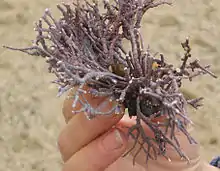
Many corallines produce chemicals which promote the settlement of the larvae of certain herbivorous invertebrates, particularly abalone. Larval settlement is adaptive for the corallines because the herbivores remove epiphytes which might otherwise smother the crusts and preempt available light. Settlement is also important for abalone aquaculture; corallines appear to enhance larval metamorphosis and the survival of larvae through the critical settlement period. It also has significance at the community level; the presence of herbivores associated with corallines can generate patchiness in the survival of young stages of dominant seaweeds. This has been seen this in eastern Canada, and it is suspected the same phenomenon occurs on Indo-Pacific coral reefs, yet nothing is known about the herbivore enhancement role of Indo-Pacific corallines, or whether this phenomenon is important in coral reef communities.
Some coralline algae develop into thick crusts which provide microhabitat for many invertebrates. For example, off eastern Canada, Morton found juvenile sea urchins, chitons, and limpets suffer nearly 100% mortality due to fish predation unless they are protected by knobby and undercut coralline algae. This is probably an important factor affecting the distribution and grazing effects of herbivores within marine communities. Nothing is known about the microhabitat role of Indo-Pacific corallines. However, the most common species in the region, Hydrolithon onkodes, often forms an intimate relationship with the chiton Cryptoplax larvaeformis. The chiton lives in burrows it makes in H. onkodes plants, and comes out at night to graze on the surface of the coralline. This combination of grazing and burrowing results in a peculiar growth form (called "castles") in H. onkodes, in which the coralline produces nearly vertical, irregularly curved lamellae. Coralline algae are part of the diet of shingle urchins (Colobocentrotus atratus).
Nongeniculate corallines are of particular significance in the ecology of coral reefs, where they add calcareous material to the structure of the reef, help cement the reef together, and are important sources of primary production. Coralline algae are especially important in reef construction, as they lay down calcium carbonate as calcite. Although they contribute considerable bulk to the calcium carbonate structure of coral reefs, their more important role in most areas of the reef, is in acting as the cement which binds the reef materials into a sturdy structure.[38]
Corallines are particularly important in constructing the algal ridge's reef framework for surf-pounded reefs in both the Atlantic and Indo-Pacific regions. Algal ridges are carbonate frameworks constructed mainly by nongeniculate coralline algae (after Adey, 1978). They require high and persistent wave action to form, so develop best on windward reefs with little or no seasonal change in wind direction. Algal ridges are one of the main reef structures that prevent oceanic waves from striking adjacent coastlines, helping to prevent coastal erosion.
Economic importance
Because of their calcified structure, coralline algae have a number of economic uses.
Some harvesting of maërl beds that span several thousand kilometres off the coast of Brazil takes place. These beds contain as-yet undetermined species belonging to the genera Lithothamnion and Lithophyllum.
Soil conditioning
The collection of unattached corallines (maërl) for use as soil conditioners dates to the 18th century. This is particularly significant in Britain and France, where more than 300,000 tonnes of Phymatolithon calcareum (Pallas, Adey & McKinnin) and Lithothamnion corallioides are dredged annually.
Medicine and food
The earliest use of corallines in medicine involved the preparation of a vermifuge from ground geniculate corallines of the genera Corallina and Jania. This use stopped towards the end of the 18th century. Medical science now uses corallines in the preparation of dental bone implants. The cell fusions provide the matrix for the regeneration of bone tissue.
Maërl is also used as a food additive for cattle and pigs, as well as in the filtration of acidic drinking water.
Aquaria
As a colorful component of live rock sold in the marine aquarium trade, and an important part of reef health, coralline algae are desired in home aquariums for their aesthetic qualities, and ostensible benefit to the tank ecosystem.
See also
- Coralline for other organisms that resemble coral, or contribute materially to reef creation
- Leptofauchea coralligena
- List of coralline algae species in the British Isles
References
- Aguirre, J.; Perfectti, F.; Braga, J.C. (2010). "Integrating phylogeny, molecular clocks, and the fossil record in the evolution of coralline algae (Corallinales and Sporolithales, Rhodophyta)". Paleobiology. 36 (4): 519. Bibcode:2010Pbio...36..519A. doi:10.1666/09041.1. S2CID 85227395.
- Riding, R.; Cope, J.C.W.; Taylor, P.D. (1998). "A coralline-like red alga from the Lower Ordovician of Wales" (PDF). Palaeontology. 41: 1069–1076. Archived from the original (PDF) on 9 March 2012.
- Brooke, C.; Riding, R. (1998). "Ordovician and Silurian coralline red algae". Lethaia. 31 (3): 185. doi:10.1111/j.1502-3931.1998.tb00506.x.
- Silva, P.; Johansen, H. W. (1986). "A reappraisal of the order Corallinales (Rhodophyceae)". European Journal of Phycology. 21 (3): 245–254. doi:10.1080/00071618600650281.
- Ballesteros E., 2006 Mediterranean coralligenous assemblages: A synthesis of present knowledge. Oceanography and Marine Biology - an Annual Review 44: 123–130
- Žuljević, A.; et al. (2016). "First freshwater coralline alga and the role of local features in a major biome transition". Sci. Rep. Nature. 6: 19642. Bibcode:2016NatSR...619642Z. doi:10.1038/srep19642. PMC 4726424. PMID 26791421.
- Woelkerling, Wm.J. (1988). The coralline red algae: An analysis of the genera and subfamilies of non-geniculate Corallinaceae. Natural History. London, UK: British Museum. ISBN 978-0-19-854249-0.
- Taylor, Thomas N; Taylor, Edith L; Krings, Michael (2009). Paleobotany: the biology and evolution of fossil plants. Academic Press. ISBN 978-0-12-373972-8.
- Žuljević, A.; Kaleb, S.; Peña, V.; Despalatović, M.; Cvitković, I.; De Clerck, O.; Le Gall, L.; Falace, A.; Vita, F.; Braga, Juan C.; Antolić, B. (2016). "Pneophyllum cetinaensis". Nature. 6: 19642. Bibcode:2016NatSR...619642Z. doi:10.1038/srep19642. PMC 4726424. PMID 26791421. srep 19642.
- Basso D, et al. (2015). "Monitoring deep Mediterranean rhodolith beds" (PDF). Aquatic Conservation: Marine and Freshwater Ecosystems. 26 (3): 3. doi:10.1002/aqc.2586.
- Blackwell, W.H.; Marak, J.H.; Powell, M.J. (1982). "The identity and reproductive structures of a misplaced Solenopora (Rhodophycophyta) from the Ordovician of southwestern Ohio and eastern Indiana". Journal of Phycology. 18 (4): 477. doi:10.1111/j.0022-3646.1982.00477.x.
- Keats, D.W.; Knight, M.A.; Pueschel, C.M. (1997). "Antifouling effects of epithallial shedding in three crustose coralline algae (Rhodophyta, Coralinales) on a coral reef". Journal of Experimental Marine Biology and Ecology. 213 (2): 281. doi:10.1016/S0022-0981(96)02771-2.
- Aguirre, J.; Riding, R.; Braga, J.C. (2000). "Diversity of coralline red algae: Origination and extinction patterns from the early Cretaceous to the Pleistocene". Paleobiology. 26 (4): 651–667. doi:10.1666/0094-8373(2000)026<0651:DOCRAO>2.0.CO;2. ISSN 0094-8373. S2CID 130399147.
- Thornton, Scott E.; Orrin, H. Pil (1978). "A lagoonal crustose coralline algal micro-ridge: Bahiret el Bibane, Tunisia". SEPM Journal of Sedimentary Research. 48. doi:10.1306/212F7554-2B24-11D7-8648000102C1865D.
- Cabioch, J. (1988). "Morphogenesis and generic concepts in coralline algae: A reappraisal". Helgoländer Meeresuntersuchungen. 42 (3–4): 493–509. Bibcode:1988HM.....42..493C. doi:10.1007/BF02365623.
- Küpper, F.C. and Kamenos, N.A. (2018) "The future of marine biodiversity and marine ecosystem functioning in UK coastal and territorial waters (including UK Overseas Territories)–with an emphasis on marine macrophyte communities". Botanica Marina, 61(6): 521-535. doi:10.1515/bot-2018-0076.
- Steneck, R.S. (1986). "The ecology of coralline algal crusts: Convergent patterns and adaptative strategies". Annual Review of Ecology and Systematics. 17: 273–303. doi:10.1146/annurev.es.17.110186.001421. JSTOR 2096997.
- Stenec, R.S. (1983). "Escalating herbivory and resulting adaptive trends in calcareous algal crusts". Paleobiology. 9k (1): 44–61. Bibcode:1983Pbio....9...44S. doi:10.1017/S0094837300007375. JSTOR 2400629. S2CID 85645519.
- Smith, M.R. and Butterfield, N.J. 2013: A new view on Nematothallus: coralline red algae from the Silurian of Gotland. Palaeontology 56, 345–359. 10.1111/j.1475-4983.2012.01203.x
- Xiao, S.; Knoll, A. H.; Yuan, X.; Pueschel, C. M. (2004). "Phosphatized multicellular algae in the Neoproterozoic Doushantuo Formation, China, and the early evolution of florideophyte red algae". American Journal of Botany. 91 (2): 214–227. doi:10.3732/ajb.91.2.214. PMID 21653378.
- Basson, P. W.; Edgell, H. S. (1971). "Calcareous algae from the Jurassic and Cretaceous of Lebanon". Micropaleontology. 17 (4): 411–433. Bibcode:1971MiPal..17..411B. doi:10.2307/1484871. JSTOR 1484871.
- Johnson, J. H. (May 1956). "Ancestry of the Coralline algae". Journal of Paleontology. 30 (3): 563–567. ISSN 0022-3360. JSTOR 1300291.
- Bittner, L.; Payri, C. E.; Maneveldt, G. W.; Couloux, A.; Cruaud, C.; De Reviers, B.; Le Gall, L. (2011). "Evolutionary history of the Corallinales (Corallinophycidae, Rhodophyta) inferred from nuclear, plastidial and mitochondrial genomes" (PDF). Molecular Phylogenetics and Evolution. 61 (3): 697–713. doi:10.1016/j.ympev.2011.07.019. hdl:10566/904. PMID 21851858.
- Auer, Gerald; Piller, Werner E. (14 February 2020). "Nanocrystals as phenotypic expression of genotypes—An example in coralline red algae". Science Advances. 6 (7): eaay2126. Bibcode:2020SciA....6.2126A. doi:10.1126/sciadv.aay2126. PMC 7015681. PMID 32095524.
- "Taxonomy Browser :: Algaebase". www.algaebase.org.
- Athanasiadis, Athanasios (January 2, 2019). "Amphithallia, a genus with four-celled carpogonial branches and connecting filaments in the Corallinales (Rhodophyta)". Marine Biology Research. 15 (1): 13–25. Bibcode:2019MBioR..15...13A. doi:10.1080/17451000.2019.1598559. S2CID 155866871 – via Taylor and Francis+NEJM.
- Riosmena-Rodríguez, Rafael; Wendy, Nelson; Julio, Aguirre (2016). Rhodolith/Maërl Beds : a global perspective. Switzerland. ISBN 978-3-319-29313-4.
{{cite book}}: CS1 maint: location missing publisher (link) - Dulin, Tuvia; Avnaim-Katav, Simona; Sisma-Ventura, Guy; Bialik, Or M.; Angel, Dror L. (January 2020). "Rhodolith beds along the southeastern Mediterranean inner shelf: Implications for past depositional environments". Journal of Marine Systems. 201: 103241. Bibcode:2020JMS...20103241D. doi:10.1016/j.jmarsys.2019.103241. S2CID 210297206.
- Basso, Daniela (March 2012). "Carbonate production by calcareous red algae and global change". Geodiversitas. 34 (1): 13–33. doi:10.5252/g2012n1a2. S2CID 86112464.
- Littler, Mark M.; Littler, Diane S.; Blair, Stephen M.; Norris, James N. (4 January 1985). "Deepest Known Plant Life Discovered on an Uncharted Seamount". Science. 227 (4682): 57–59. Bibcode:1985Sci...227...57L. doi:10.1126/science.227.4682.57. PMID 17810025. S2CID 20905891.
- Deep-water plant communities from an uncharted seamount off San Salvador Island, Bahamas: distribution, abundance, and primary productivity
- Bialik, Or M.; Varzi, Andrea Giulia; Durán, Ruth; Le Bas, Timothy; Gauci, Adam; Savini, Alessandra; Micallef, Aaron (25 February 2022). "Mesophotic Depth Biogenic Accumulations ("Biogenic Mounds") Offshore the Maltese Islands, Central Mediterranean Sea". Frontiers in Marine Science. 9: 803687. doi:10.3389/fmars.2022.803687.
- Btracchi, Valentina; Savini, Alessandra; Marchese, Fabio; Palamara, Serena; Basso, Daniela; Corselli, Cesare (February 2015). "Coralligenous habitat in the Mediterranean Sea: a geomorphological description from remote". Italian Journal of Geosciences. 134 (1): 32–40. doi:10.3301/IJG.2014.16.
- Coletti; et al. (2017). "Economic Importance of Coralline Carbonates". In Riosmena-Rodríguez; et al. (eds.). Rhodolith/Maërl Beds: A Global Perspective. Coastal Research Library. Vol. 15. pp. 87–101. doi:10.1007/978-3-319-29315-8_4. ISBN 978-3-319-29313-4.
- Baas-Becking, L. G.; Galliher, E. W. (1931). "Wall structure and mineralization in coralline algae". Journal of Physical Chemistry. 35 (2): 467–479. doi:10.1021/j150320a006.
- Basso D, Granier B (2012). "Carbonate production by calcareous red algae and global change". Geodiversitas. Calcareous algae and global change: from identification to quantification. 34: 13–33. doi:10.5252/g2012n1a2. S2CID 86112464.
- Irvine, Linda M.; Chamberlain, Yvonne M. (1994). Corallinales, Hildenbrandiales. London, UK: Her Majesty's Stationery Office. ISBN 978-0-11-310016-3.
- Caragnano et al., 2009. 3-D distribution of nongeniculate corallinales: A case study from a reef crest of South Sinai (Red Sea, Egypt). Coral Reefs 28: 881-891
Further reading
- Morton, O.; Chamberlain, Y.M. (1985). "Records of some epiphytic coralline algae in the north-east of Ireland". Ireland Naturalists' Journal. 21: 436–440.
- Morton, O.; Chamberlain, Y.M. (1989). "Further records of encrusting coralline algae on the north-east coast of Ireland". Irish Naturalists' Journal. 23: 102–106.
- Suneson, S (1943). "The structure, life-history, and taxonomy of the Swedish Corallinaceae". Acta Universitatis Lundensis. N.F. Avd. 2. 39 (9): 1–66.
- Woelkerling, W. J. (1993). "Type collections of Corallinales (Rhodophyta) in the Foslie Herbarium (TRH)". Gunneria. 67: 1–289.
- "ITIS Report for Corallinaceae".
External links
- British Phycological Society
- Seaweed Site
- Algaebase :: Listing the World's Algae AlgaeBase
- "Coralline algae". New Zealand: University of the Western Cape. 2006-09-24. Archived from the original on 2006-09-24.
- Adey. "The coralline genus Clathromorphum Foslie emend". Biological, physiological, and ecological factors controlling carbonate production in an Arctic/sub-Arctic climate archive. Federal Depository Library Program. GPO 45844.
